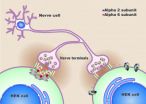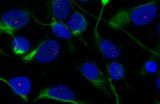(Press-News.org) A new way to study the role of a critical neurotransmitter in disorders such as epilepsy, anxiety, insomnia, depression, schizophrenia, and alcohol addiction has been developed by a group of scientists led by Gong Chen, an associate professor of biology at Penn State University. The new method involves molecularly engineering a model synapse -- a structure through which a nerve cell send signals to another cell. This model synapse can precisely control a variety of receptors for the neurotransmitter called GABA, which is important in brain chemistry. The research, which will be published in the Journal of Biological Chemistry on 10 August 2012, opens the door to the possibility of creating safer and more-efficient drugs that target GABA receptors and that cause fewer side effects.
Neurotransmitters -- chemicals sent by nerves to trigger other cells to change their electrical responses -- interact with special receptors located on the cell's outer membrane. These receptors form inside the cell, and then are transported to different locations on the membrane to await the arrival of neurotransmitters. Chen explained that understanding how these receptors work and how they move to various locations on a cell's membrane is a critical step toward the development of new drugs targeting diseases that affect brain chemistry.
In their study, Chen and his team focused on a particular receptor -- called the GABA-A receptor-- that responds to the neurotransmitter GABA. "The GABA-A receptors are associated with various disorders in which nerve-cell excitability is altered, such as epilepsy and anxiety, and these receptors mediate major inhibition in the brain," Chen explained. "Each GABA-A receptor protein is made up of five subunits and there are 19 possible subunits that can combine in various ways to form any single receptor. We focused on a particular group of subunits called Alpha, and how changing these tiny subunits might affect the GABA-A receptor's location on the cell membrane."
First, Chen and his team used molecular engineering techniques to develop a model synapse between a nerve cell and a special kind of kidney cell used widely in cell-biology research -- called an HEK cell -- in order to study how specific receptors behaved. They then altered the Alpha subunits in the GABA-A receptors expressed in the kidney cell in order to test how a single variation might affect the behavior of the receptor. They found that the receptors behaved very differently in response to the GABA neurotransmitter, depending on whether they had an Alpha 2 or an Alpha 6 subunit. "Not only do the Alpha subunits play an important role in determining how the GABA-A receptor responds to the neurotransmitter, but the Alpha 2 and Alpha 6 subunits also guide the receptors to very different regions on the cell membrane," Chen said.
Specifically, Chen and his collaborators found that when a GABA-A receptor had an Alpha 2 subunit, the receptor tended to cluster at the synaptic region on the cell membrane. However, when a GABA-A receptor had an Alpha 6 subunit, the receptor tended to migrate to a different area on the cell membrane called the extrasynaptic region.
Chen explained that understanding such a difference in receptor behavior can be especially important in predicting what side effects a drug might cause. For example, many GABA-receptor-targeting drugs such as Valium and Xanax, which are used to treat anxiety, appear to directly change the GABA neurotransmitter's synaptic transmission, significantly altering nerve-cell activity and causing side effects such as confusion, agitation, and memory loss.
"If we imagine that a cell represents a big city, then the synaptic regions are major highways leading to the city," Chen said. "There are serious side effects of disrupting those 'major highways' because brain function relies upon a delicate excitation-inhibition balance and breaking that balance will affect the output of neural circuits." Chen added that, in the same analogy, the extrasynaptic regions could be thought of as the less-trafficked, but numerous smaller roads. "The idea is that if drugs could be developed that manipulate only the extrasynaptic receptors rather than the synaptic receptors, the 'major highways' would remain undisturbed and the heavy traffic could continue with less interruption. That is, targeting extrasynaptic receptors by modulating the Alpha 6 subunit represents a step toward creating new drugs with fewer side effects."
INFORMATION:
In addition to Chen, other researchers who contributed to this study include Xia Wu, Zheng Wu, Gang Ning, Yao Guo, and Bernhard Luscher from Penn State; Rashid Ali and Angel L. De Blas from the University of Connecticut; and Robert L. Macdonald from Vanderbilt University.
The research is supported by two organizations of the U.S. National Institutes of Health: the National Institute of Neurological Disorders and Stroke and the National Institute of Mental Health.
[ Katrina Voss ]
CONTACTS
Barbara Kennedy (PIO): 814-863-4682, science@psu.edu
IMAGE
A high-resolution illustration is online at http://www.science.psu.edu/news-and-events/2012-news/Chen8-2012
CAPTION
Model synapses revealed that, when a GABA-A receptor had Alpha 2 subunits, the receptor tended move toward and form at the synaptic region. However, when a GABA-A receptor had Alpha 6 subunits, the receptor tended to move toward the extrasynaptic region.
CREDIT
Gong Chen lab, Penn State
GRANT NUMBERS
National Institute of Neurological Disorders and Stroke (NS054858, NS38752, NS33300) and National Institute of Mental Health (MH083911, MH062391)
New model synapse could shed light on disorders such as epilepsy and anxiety
2012-08-08
ELSE PRESS RELEASES FROM THIS DATE:
Doctors often don't disclose all possible risks to patients before treatment
2012-08-08
Most informed consent disputes involve disagreements about who said what and when, not stand-offs over whether a particular risk ought to have been disclosed. But doctors may "routinely underestimate the importance of a small set of risks that vex patients" according to international experts writing in this week's PLOS Medicine.
Increasingly, doctors are expected to advise and empower patients to make rational choices by sharing information that may affect treatment decisions, including risks of adverse outcomes. However, authors from Australia and the US led by David ...
Patients want more risks disclosed before treatment
2012-08-08
Australian doctors sometimes fail to warn patients of risks that could affect the patient's quality of life before providing treatment or surgery, a new study led by University of Melbourne researchers has shown.
Published in PLoS Medicine today, the study showed that some doctors, particularly surgeons, are not explaining the risk of specific outcomes that matter most to patients.
Overlooked risks that led to a legal claim or complaint included chronic pain, sexual dysfunction, visual or hearing loss, and the need for re-operation.
Lead author Dr Marie Bismark from ...
Molecular economics: New computer models calculate systems-wide costs of gene expression
2012-08-08
Bioengineers at the University of California, San Diego have developed a method of modeling, simultaneously, an organism's metabolism and its underlying gene expression. In the emerging field of systems biology, scientists model cellular behavior in order to understand how processes such as metabolism and gene expression relate to one another and bring about certain characteristics in the larger organism.
In addition to serving as a platform for investigating fundamental biological questions, this technology enables far more detailed calculations of the total cost ...
Marin County's high breast cancer rate may be tied to genetics
2012-08-08
Marin County, California has one of the highest rates of breast cancer in the world, a fact that scientists know has nothing to do with the land itself but with some other, unknown factor.
A new study that analyzed mouth buccal cell samples stored frozen at the University of California, San Francisco (UCSF) suggests what this factor may be: a genetic trait present among women within the county's predominantly white population.
In an article published online this week by the Journal of the American College of Surgeons, which will appear in the November 2012 print issue, ...
A molecule central to diabetes is uncovered
2012-08-08
At its most fundamental level, diabetes is a disease characterized by stress -- microscopic stress that causes inflammation and the loss of insulin production in the pancreas, and system-wide stress due to the loss of that blood-sugar-regulating hormone.
Now, researchers led by scientists at the University of California, San Francisco (UCSF) have uncovered a new key player in amplifying this stress in the earliest stages of diabetes: a molecule called thioredoxin-interacting protein (TXNIP). The molecule, they've discovered, is central to the inflammatory process that ...
Study sheds light on underlying causes of impaired brain function in muscular dystrophy
2012-08-08
The molecular missteps that disrupt brain function in the most common form of adult-onset muscular dystrophy have been revealed in a new study published by Cell Press. Myotonic dystrophy is marked by progressive muscle wasting and weakness, as well as excessive daytime sleepiness, memory problems, and mental retardation. A new mouse model reported in the August 9 issue of the journal Neuron reproduces key cognitive and behavioral symptoms of this disease and could be used to develop drug treatments, which are currently lacking.
"The new animal model reproduces important ...
The first public data release from BOSS, the Baryon Oscillation Spectroscopic Survey
2012-08-08
The Third Sloan Digital Sky Survey (SDSS-III) has issued Data Release 9 (DR9), the first public release of data from the Baryon Oscillation Spectroscopic Survey (BOSS). In this release BOSS, the largest of SDSS-III's four surveys, provides spectra for 535,995 newly observed galaxies, 102,100 quasars, and 116,474 stars, plus new information about objects in previous Sloan surveys (SDSS-I and II).
"This is just the first of three data releases from BOSS," says David Schlegel of the U.S. Department of Energy's Lawrence Berkeley National Laboratory (Berkeley Lab), an astrophysicist ...
EARTH: Shake, rattle and roll
2012-08-08
Alexandria, VA – A team of researchers may have discovered a way to hear earthquakes. Not the noises of rattling windows and crumbling buildings, but the real sounds an earthquake makes deep underground as rock grinds and fails catastrophically. Typical seismic waves have frequencies below the audible range for humans, but the August issue of EARTH shows you where to find the voice of one seismic monster: the March 11, 2011, magnitude-9.0 Tohoku earthquake in Japan.
Beyond the novelty of simply hearing an earthquake, the team found that the new technology could possibly ...
UK hotel industry alive with innovation
2012-08-08
Large hotel chains are quick to adopt and adapt innovations developed in other industries, while smaller hotels make almost continual incremental changes in response to customers' needs. The UK hotel industry is alive with innovation and new ways of improving service for customers, research funded by the Economic and Social Research Council (ESRC) has found.
The findings of a project led by Professor Gareth Shaw of Exeter University and Professor Allan Williams of Surrey University run counter to the traditional image of the hotel sector as slow to change. Official measures ...
Unusual weather events identified during the Black Saturday bushfires
2012-08-08
Research has revealed that the extremely hot, dry and windy conditions on Black Saturday combined with structures in the atmosphere called 'horizontal convective rolls' -similar to streamers of wind flowing through the air - which likely affected fire behaviour.
The study is the first of its kind to produce such detailed, high-resolution simulations of weather patterns on the day and provides insights for future fire management and warning systems.
The work was led by Dr Todd Lane and Ms Chermelle Engel from The University of Melbourne with Prof Michael Reeder (Monash ...





